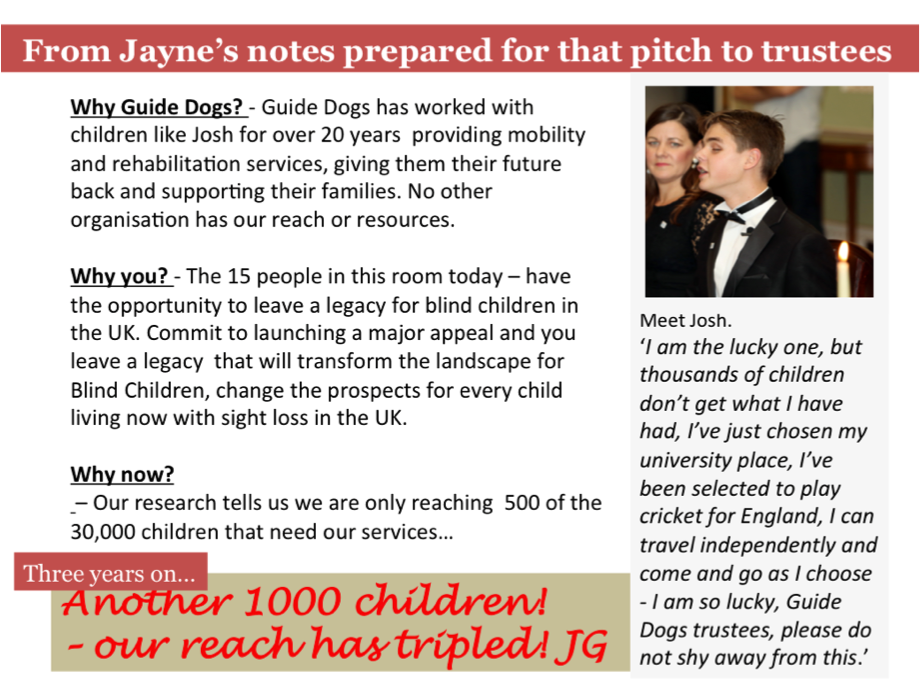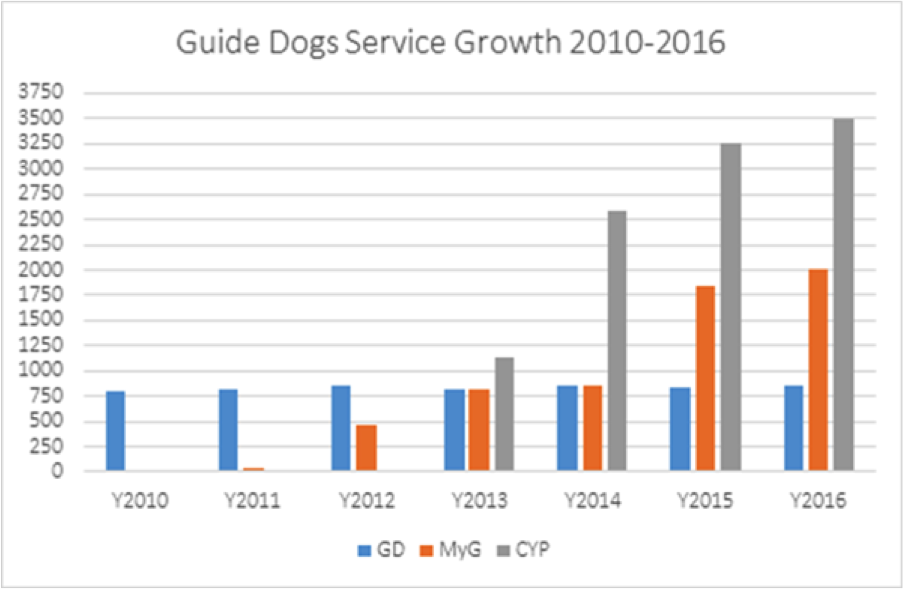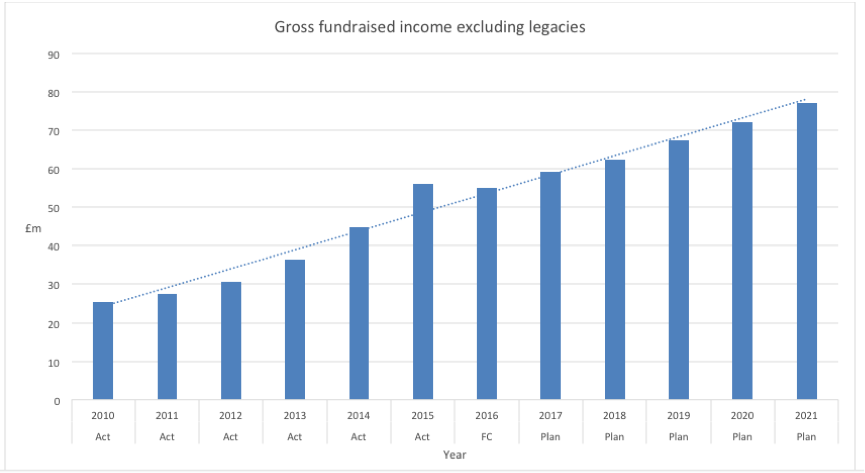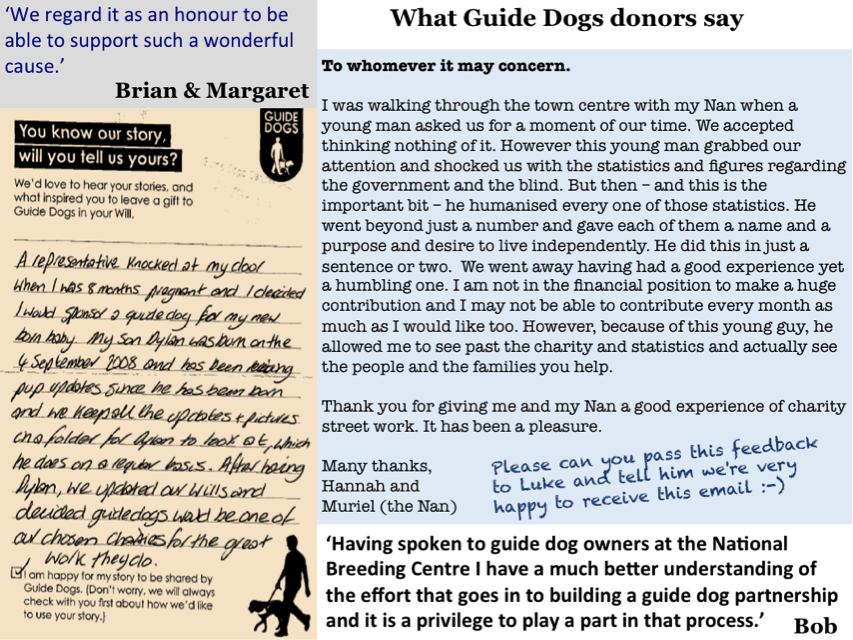CDE project 6 section 5.4a: ‘emotional fundraising must be in our DNA!’
From CDE project 6: the use and misuse of emotion, section 5, the inspiration business, article 5.4a.
- Written by
- Jayne George
- Added
- April 30, 2017
It’s a big step, to change the culture of an organisation, to refocus and in the process to take everyone in the organisation with you, no exceptions, so that they all, like you, will live the new ambition day in, day out as you do, each determined to make the change work, to make it stick.
Jayne George, director of fundraising and marketing at Guide Dogs, introduced just such a change into what is one of Britain’s largest, most loved and respected fundraising charities. She talked to Ken Burnett about leading an organisation into the emotional space. Ken started by asking, ‘how do you go about making this a really lasting, transformational change?’
‘Before our transformation Guide Dogs, if I’m honest, was in a bit of a rut.’ Jayne George is nothing if not direct. Indeed she’s famous for it. So it seems prudent to let her do most of the talking.
‘Some of our traditional fundraising was in decline,’ she says, ‘just when we wanted to be doing more, particularly for blind children. In some parts of the organisation fundraising was seen as a necessary evil. We also wanted to not just focus on the dogs, but to introduce our donors to the lots of other good things we do. A dog doesn’t suit everyone or all circumstances. So we needed to get a more complex, multi-service message out, but in a human and compelling way. Plus, we needed to raise lots more money for all areas of our work to enable us to reach lots of blind and partially sighted people we weren’t getting to. And lots of donors we weren’t reaching also.’
Complex can still be emotional
Jayne readily acknowledges the emotional pulling power of their wonderful four legged unique selling proposition, the guide dogs. ‘The dogs of course’, she says, ‘have always been our biggest asset, traditionally. We wanted to add to that appeal, not change it.’
In days long past the charity used to have a slogan that was one of the best emotional lines in the history of fundraising:

‘Nowadays,’ Jayne explains, ‘the Guide Dogs message is more complex and has to be focused less on the dogs – we’re not an animal charity, we’re about combating loneliness and isolation for people. Just one of the ways we do that is by providing beautiful, brilliant, superbly trained and life-changing companions, the guide dogs. Guide dogs are working dogs. They’re heroes. Sponsor a puppy is still our flagship product. But we’re more than that. We have access to many powerful inspirational stories. So I decided to use emotional fundraising as a catalyst to change the perception of Guide Dogs – so that everyone in the whole organisation would at any time, anywhere, be able to talk about the impact of our work with integrity, passion and authenticity.
‘Of course becoming an emotional organisation is not something you can do from the centre. We’d regionalised our fundraising so needed to appear both local and relevant to all of our people wherever they are. We needed to get everyone to develop the ability to tell their stories, so they could inspire and delight supporters and potential supporters everywhere.
‘To kick-start the change and let everyone see we were serious all of the senior management team went on a retreat in Scotland (with Alan Clayton and Ken Burnett at the Inch Hotel on the shores of Loch Ness, as it happens) and we were so bowled over with the potential that we saw in it that I immediately realised we had to get this vision shared by everybody, not just those with the word ‘fundraising’ in their job title. It was clear that this was to be the transformation we wanted to make and it had to embrace the whole organisation, top to bottom and all the way through.
Why the emotional fundraising route?
‘It’s simple. Emotions are why people take actions. We want people to feel responsible and engaged enough to want to support us. I’m really robust about this. We don’t want people to feel guilty, we want them to feel inspired and empowered.
‘It’s not our job to let people feel too comfortable either. Because comfortable people sit back – they do nothing. We want to engage people so they see a clear need they can do something about, where their intervention can make a real difference. So they feel good because they’ve done something great, not bad because they haven’t.
When the whole room stood up
‘For me this journey began at an induction day for new starters. I looked at the script and chucked it in the bin because it was too inward looking, all about the fundraising department and what it does and I thought, no! No, it should be about everybody feeling that they have a role to play and that fundraising is right at the heart of the organisation and all it does.
‘So I asked them, ‘stand up if you’re a fundraiser’.
‘All the fundraising staff stood up.
‘I then asked everybody, one after another, to tell an emotional story about how they’d personally been moved and engaged by Guide Dogs. They were great. At one point the whole room was blubbing. Inside an hour I asked that same question again.
‘Stand up if you’re a fundraiser.’
‘The whole room stood up.
‘That’s when I knew we were onto a winner.
Emotional fundraising has been very unifying for Guide Dogs.
‘I prepared the ground quickly after joining by making changes in the core team right from the start. As time has gone by it’s got easier and easier and now everyone buys in to the training, in fact they queue up for it. Everyone knows what emotional fundraising means and gets it. We all get the need for simplicity, what our donors, our audiences’ need, the truth told well, what interests people, how personal accounts matter and how we want to make people feel. The key is that it’s real. And we’re lucky in this because we get the most amazing real stories in letters from dog owners or from families. It’s an emotional place, Guide Dogs.
Securing trustee buy-in.
‘This was crucial from the start and literally beyond price. We could not have done it without the unreserved support of trustees.
We took them on an emotional fundraising awayday to secure their commitment and ran a mini version of our emotional fundraising course.
‘Like many charities we used to have a stop/start approach to investment. You know, can we afford it? We insisted that we forget that fundraising budgets were in competition with other budgets. We had to grow our income in an extraordinary way. To do that, we couldn’t be hamstrung by lack of investment.
‘This was when the National Blind Children Society was in trouble and we needed to step up with sustained, substantial extra support. So I challenged the trustees and said, ‘Your legacy can be that these services disappear, or your legacy can be that that you changed the world, for blind children. It’s your choice.
‘I knew we’d succeeded when, as the day was drawing to a close, the honorary treasurer turned to me and said, ‘How much do you need?’ It was a pivotal moment. From then on, there was no looking back.’

‘Sadly, later that trustee died. His wife insisted that all gifts from his funeral and in memoriam page should go to Guide Dogs because he believed so completely in what we were trying to do.
‘We secured Guide Dogs trustees’ wholehearted commitment to invest in our five-year fundraising plan. No more stop/start, we were able to put long-term relationships in place with all key suppliers. This was essential to insulate us against the unexpected and allowed us to make sure that all key suppliers and their people could also get as immersed, enthusiastic and well informed as the rest of us.
‘Of course there were challengers, questioners, people impatient for returns. We created a five-year spreadsheet to show fundraising investment compared to what might have been if we’d put a similar amount into stocks and shares. The return from fundraising was 16 times.
‘Our brand proposition is now built on storytelling.’
The unlikely fundraisers
‘I am so proud of the team at Guide Dogs who have been brave enough to be part of a real step-change in ambition – and income targets! Targets ambitious enough they will enable the Guide Dogs family to reach more blind and partially-sighted people than ever before through more services than ever before. Our income increased by almost 20 per cent in the first year of our ‘transformation’ – and we’ve been growing income by at least that much each year since.
‘I knew it was working when Liz, manager at our national dog breeding centre, told us with such enthusiasm that fresh from her new focus on fundraising she’s now doubled the income she raises from visitors to the centre. I have never been so proud to be a fundraiser. ‘And if anyone in Guide Dogs might have thought herself not a fundraiser, it could have been Liz. That’s how much we’ve changed. ’
How has Guide Dogs changed?
‘The only point of it all,’ says Jayne, ‘is if we are able to reach more people with better services, while keeping our donors happy and involved. Guide Dogs now has seen a massive growth in services, growing to offer blind and partially sighted people more than 100 million mobility hours in a year – all funded by happier donors inspired by emotional fundraising, eagerly supporting our work.


At the start of Guide Dogs’ great journey it did seem a mammoth and hugely ambitious undertaking. At the emotional fundraising workshops people arrived unsure, hesitant, a little apprehensive. They left inspired and changed, thinking they worked for the best cause anywhere. Everyone now feels part of the mission. Jayne puts this nicely.
‘I remember years ago someone interviewed a floor sweeper at NASA and asked her what she did. She answered, ‘I sweep the floors here, but really I’m here as part of the team that will put a man on the moon.’
‘Now that really is the truth, told well. We all feel like that here, all of the time. Everybody gets where they fit. We all know what we’re here to do.’

How do donors benefit?
‘They see the organisation differently. They feel part of it too. Engagement is longer, attrition is lower, complaints are negligible, we send something out and we get bags of letters back from happy donors. It matters. If you get this right, people will flock to your cause. Yes, for sure, it matters.’


















